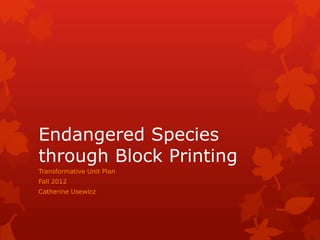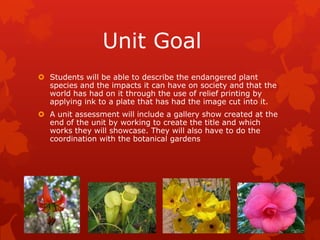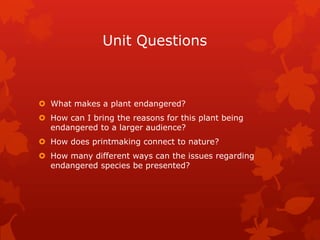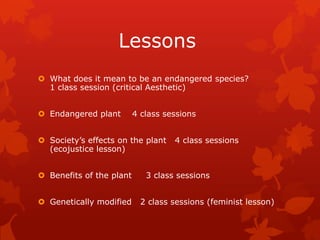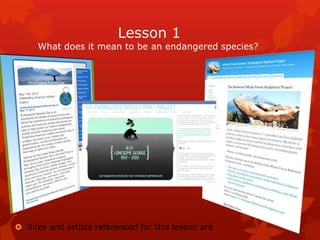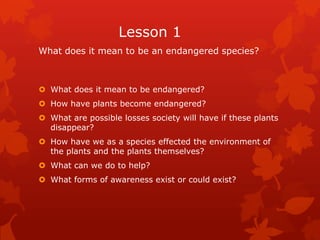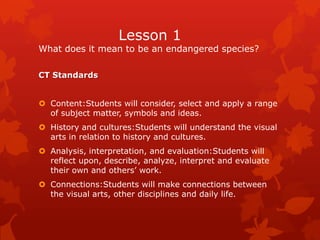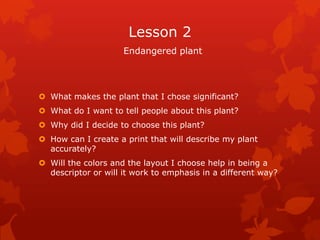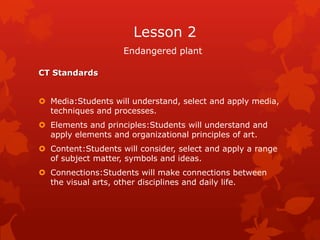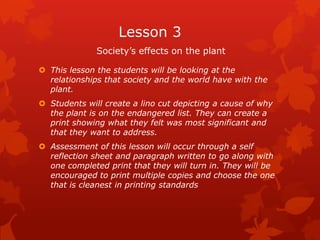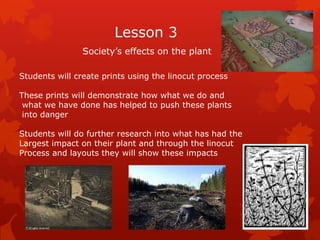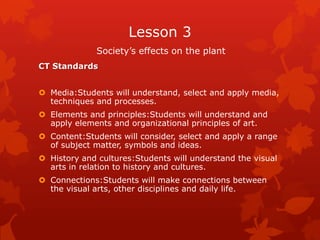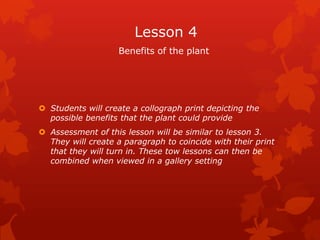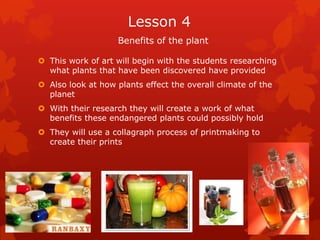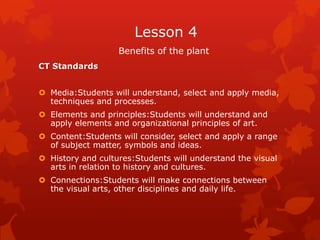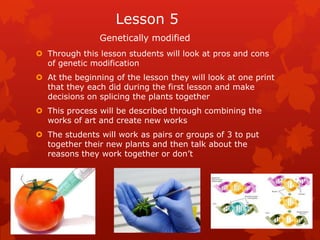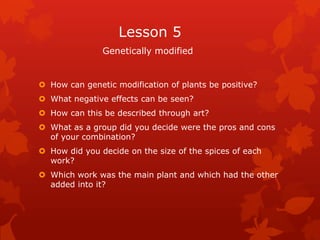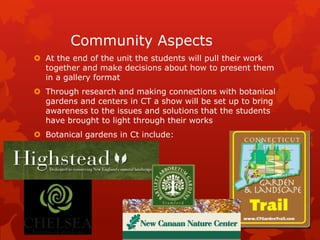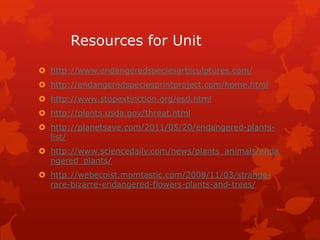Endangered species through block printing
- 1. Endangered Species through Block Printing Transformative Unit Plan Fall 2012 Catherine Usewicz
- 2. Unit Overview ď‚› Through this unit students will begin to explore endangered plant species. They will be hands on in choosing the plants that they will work to understand more at a larger level. Exploration of the issues surrounding how society has impacted the reason the species is endangered and the possible ripple effects that it could make. ď‚› The students will look at what benefits the plant could provide and create scenarios through their artwork showing these possible benefits. This unit will also look at what is happening in the world of Science in way of genetically modifying plants to create solutions.
- 3. Unit Goal ď‚› Students will be able to describe the endangered plant species and the impacts it can have on society and that the world has had on it through the use of relief printing by applying ink to a plate that has had the image cut into it. ď‚› A unit assessment will include a gallery show created at the end of the unit by working to create the title and which works they will showcase. They will also have to do the coordination with the botanical gardens
- 4. Unit Questions ď‚› What makes a plant endangered? ď‚› How can I bring the reasons for this plant being endangered to a larger audience? ď‚› How does printmaking connect to nature? ď‚› How many different ways can the issues regarding endangered species be presented?
- 5. Lessons  What does it mean to be an endangered species? 1 class session (critical Aesthetic)  Endangered plant 4 class sessions  Society’s effects on the plant 4 class sessions (ecojustice lesson)  Benefits of the plant 3 class sessions  Genetically modified 2 class sessions (feminist lesson)
- 6. Lesson 1 What does it mean to be an endangered species? ď‚› Responding session looking with the students at plants, and at artists that depict nature and conservation in their works ď‚› Students will look at how they think plants become endangered and what is happening in an overview to cause a species to become endangered ď‚› The students will fuel the questioning and discuss what their theories are regarding what it means to be endangered, how a plant becomes endangered and what can be done ď‚› Assessment will be collection of their thoughts on the questions within the class session. These will be on a sheet with clipart from the sites that will be reviewed and explored during the class session
- 7. Lesson 1 What does it mean to be an endangered species? ď‚› Sites and artists referenced for this lesson are
- 8. Lesson 1 What does it mean to be an endangered species? ď‚› What does it mean to be endangered? ď‚› How have plants become endangered? ď‚› What are possible losses society will have if these plants disappear? ď‚› How have we as a species effected the environment of the plants and the plants themselves? ď‚› What can we do to help? ď‚› What forms of awareness exist or could exist?
- 9. Lesson 1 What does it mean to be an endangered species? CT Standards  Content:Students will consider, select and apply a range of subject matter, symbols and ideas.  History and cultures:Students will understand the visual arts in relation to history and cultures.  Analysis, interpretation, and evaluation:Students will reflect upon, describe, analyze, interpret and evaluate their own and others’ work.  Connections:Students will make connections between the visual arts, other disciplines and daily life.
- 10. Lesson 2 Endangered plant ď‚› Students will research and pick a plant that they will create a series of prints with. For the intro to relief they will use Styrofoam and a variety of colors for inking ď‚› Assessment will be having at least 4 prints completed and handed in of their plate that they created. Also turning in the plate and demonstrating block printing techniques through their prints
- 11. Lesson 2 Endangered plant ď‚› In the first lesson students will begin learning the concepts and techniques of block printing and relief techniques by carving their plant design ď‚› They will create multiple prints exploring colors and pressure to create the prints ď‚› During the first lesson the students will begin their research and choose a plant to learn more about and present ď‚› They will research the name and location, then more research will be done through the course of the unit
- 12. Lesson 2 Endangered plant ď‚› What makes the plant that I chose significant? ď‚› What do I want to tell people about this plant? ď‚› Why did I decide to choose this plant? ď‚› How can I create a print that will describe my plant accurately? ď‚› Will the colors and the layout I choose help in being a descriptor or will it work to emphasis in a different way?
- 13. Lesson 2 Endangered plant CT Standards ď‚› Media:Students will understand, select and apply media, techniques and processes. ď‚› Elements and principles:Students will understand and apply elements and organizational principles of art. ď‚› Content:Students will consider, select and apply a range of subject matter, symbols and ideas. ď‚› Connections:Students will make connections between the visual arts, other disciplines and daily life.
- 14. Lesson 3 Society’s effects on the plant  This lesson the students will be looking at the relationships that society and the world have with the plant.  Students will create a lino cut depicting a cause of why the plant is on the endangered list. They can create a print showing what they felt was most significant and that they want to address.  Assessment of this lesson will occur through a self reflection sheet and paragraph written to go along with one completed print that they will turn in. They will be encouraged to print multiple copies and choose the one that is cleanest in printing standards
- 15. Lesson 3 Society’s effects on the plant Students will create prints using the linocut process These prints will demonstrate how what we do and what we have done has helped to push these plants into danger Students will do further research into what has had the Largest impact on their plant and through the linocut Process and layouts they will show these impacts
- 16. Lesson 3 Society’s effects on the plant  What we have done to the plant?  How have our values hurt the plant?  How can I describe through the composition what effects the plant has felt?  What are we doing subconciously that is effecting the plant?  How does this process of printmaking have connections to nature?
- 17. Lesson 3 Society’s effects on the plant CT Standards  Media:Students will understand, select and apply media, techniques and processes.  Elements and principles:Students will understand and apply elements and organizational principles of art.  Content:Students will consider, select and apply a range of subject matter, symbols and ideas.  History and cultures:Students will understand the visual arts in relation to history and cultures.  Connections:Students will make connections between the visual arts, other disciplines and daily life.
- 18. Lesson 4 Benefits of the plant ď‚› Students will create a collograph print depicting the possible benefits that the plant could provide ď‚› Assessment of this lesson will be similar to lesson 3. They will create a paragraph to coincide with their print that they will turn in. These tow lessons can then be combined when viewed in a gallery setting
- 19. Lesson 4 Benefits of the plant ď‚› This work of art will begin with the students researching what plants that have been discovered have provided ď‚› Also look at how plants effect the overall climate of the planet ď‚› With their research they will create a work of what benefits these endangered plants could possibly hold ď‚› They will use a collagraph process of printmaking to create their prints
- 20. Lesson 4 Benefits of the plant  What possible benefits could this plant hold?  What could have been discovered from plants that went extinct from society’s effects on nature?  How does collagraph printing add dimension to the print?
- 21. Lesson 4 Benefits of the plant CT Standards ď‚› Media:Students will understand, select and apply media, techniques and processes. ď‚› Elements and principles:Students will understand and apply elements and organizational principles of art. ď‚› Content:Students will consider, select and apply a range of subject matter, symbols and ideas. ď‚› History and cultures:Students will understand the visual arts in relation to history and cultures. ď‚› Connections:Students will make connections between the visual arts, other disciplines and daily life.
- 22. Lesson 5 Genetically modified  In this lesson the original prints of the plant will all be placed at the front and students will talk about all the information provided as to what the benefits each plant are.  They will make decisions about combining all the plants and the pros and cons.  The final work will be made by students working in pairs to modify their works by splicing a section of their print with their partner’s print.  Assessment of this lesson will occur through turning in 2 completed works per group of 2 or 3. Each of these works will have parts from each piece and a description of why they chose which was the main plant and which was added.
- 23. Lesson 5 Genetically modified  Through this lesson students will look at pros and cons of genetic modification  At the beginning of the lesson they will look at one print that they each did during the first lesson and make decisions on splicing the plants together  This process will be described through combining the works of art and create new works  The students will work as pairs or groups of 3 to put together their new plants and then talk about the reasons they work together or don’t
- 24. Lesson 5 Genetically modified ď‚› How can genetic modification of plants be positive? ď‚› What negative effects can be seen? ď‚› How can this be described through art? ď‚› What as a group did you decide were the pros and cons of your combination? ď‚› How did you decide on the size of the spices of each work? ď‚› Which work was the main plant and which had the other added into it?
- 25. Lesson 5 Genetically modified CT Standards  Media:Students will understand, select and apply media, techniques and processes.  Elements and principles:Students will understand and apply elements and organizational principles of art.  Content:Students will consider, select and apply a range of subject matter, symbols and ideas.  Analysis, interpretation, and evaluation:Students will reflect upon, describe, analyze, interpret and evaluate their own and others’ work.  Connections:Students will make connections between the visual arts, other disciplines and daily life.
- 26. Community Aspects ď‚› At the end of the unit the students will pull their work together and make decisions about how to present them in a gallery format ď‚› Through research and making connections with botanical gardens and centers in CT a show will be set up to bring awareness to the issues and solutions that the students have brought to light through their works ď‚› Botanical gardens in Ct include:
- 27. Resources for Unit ď‚› http://www.endangeredspeciesartsculptures.com/ ď‚› http://endangeredspeciesprintproject.com/home.html ď‚› http://www.stopextinction.org/esd.html ď‚› http://plants.usda.gov/threat.html ď‚› http://planetsave.com/2011/05/20/endangered-plants- list/ ď‚› http://www.sciencedaily.com/news/plants_animals/enda ngered_plants/ ď‚› http://webecoist.momtastic.com/2008/11/03/strange- rare-bizarre-endangered-flowers-plants-and-trees/

